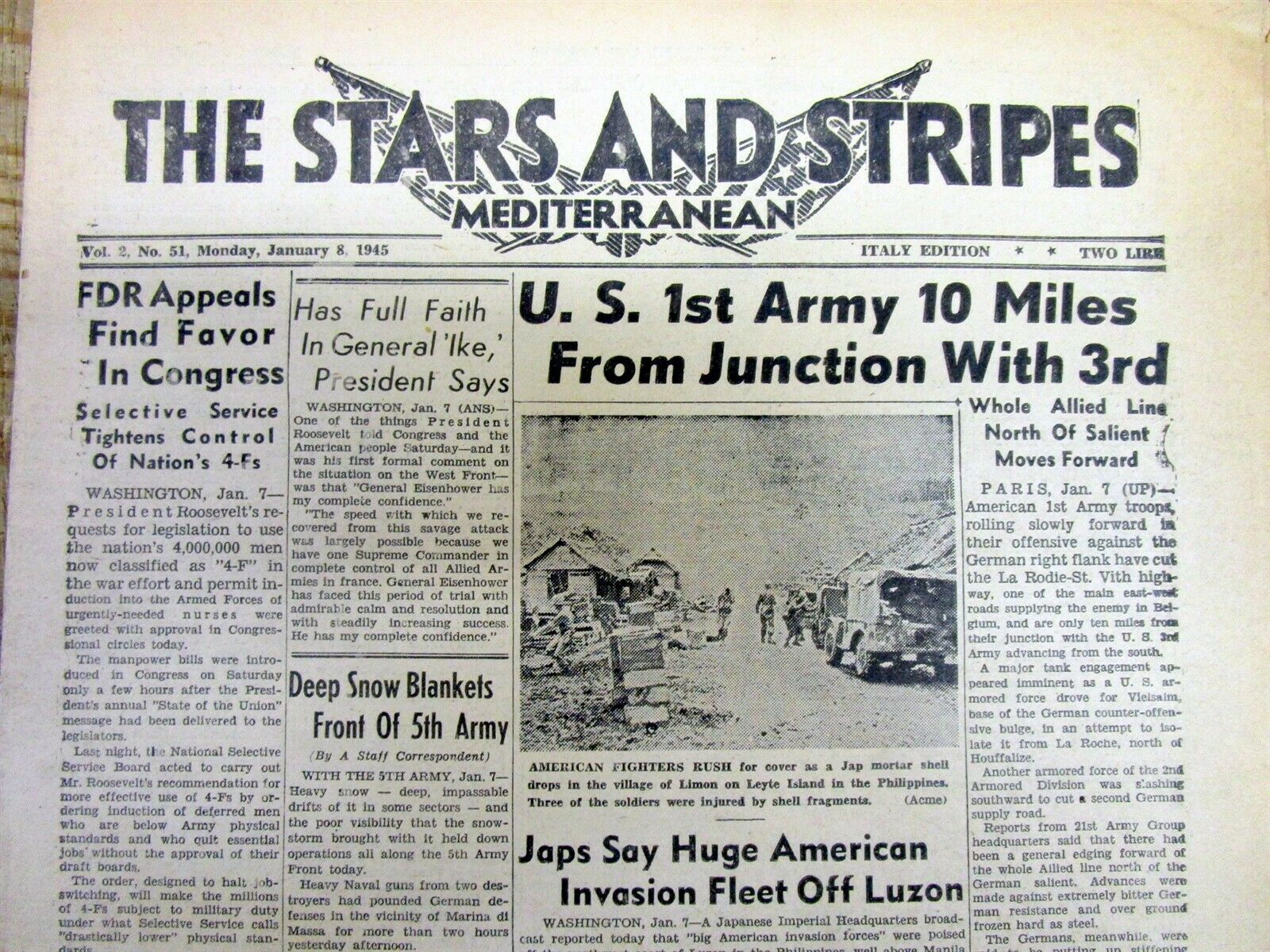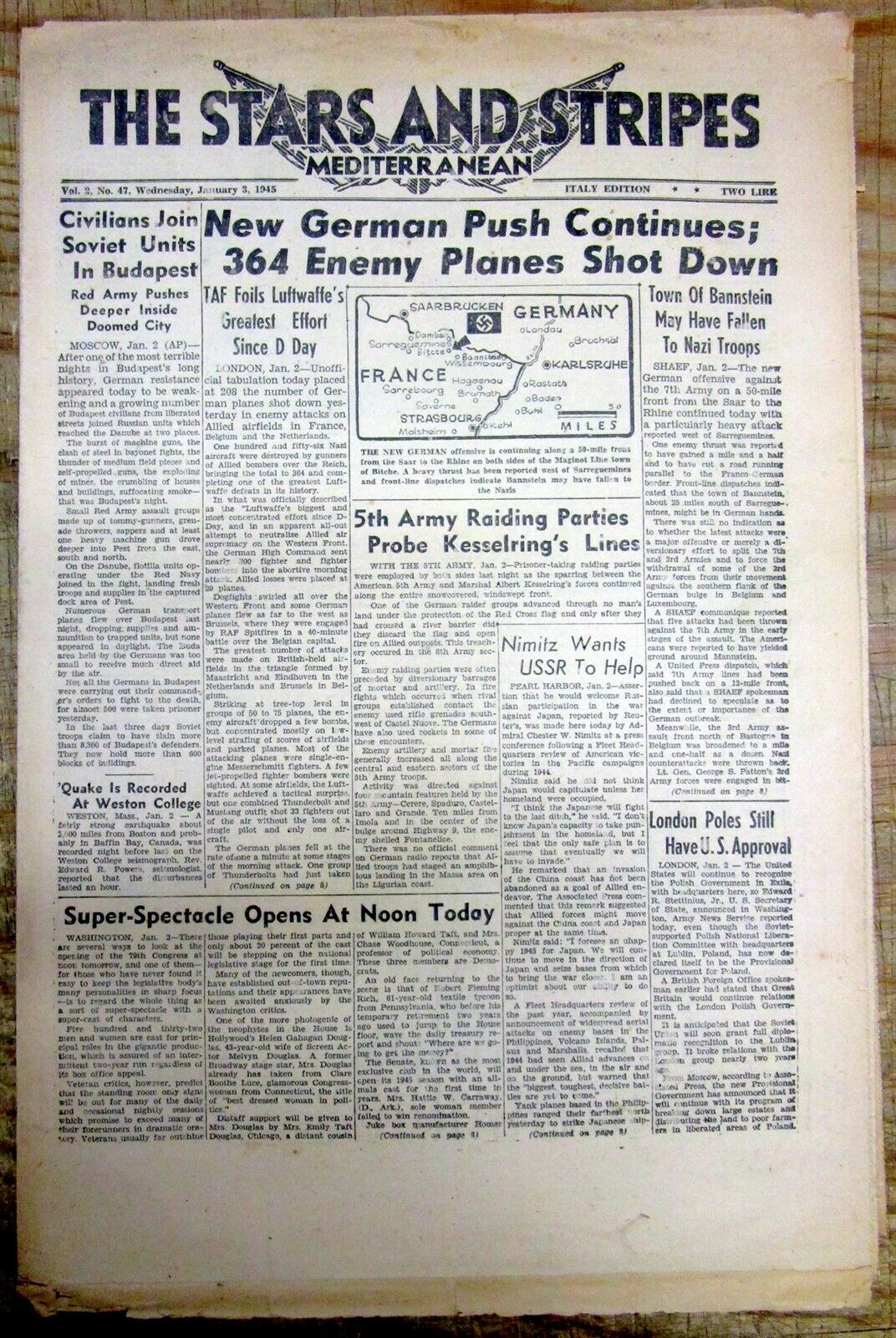-40%
1945 WW II Stars & Stripes newspapers BATTLE ofTHE BULGE US defeats Nazi Germany
$ 21.12
- Description
- Size Guide
Description
1945 WW II Stars & Stripes newspapers BATTLE ofTHE BULGE US defeats Nazi Germany2 1945 WW II Stars & Stripes newspapers BATTLE of the BULGE - US defeats Nazi Germany
- inv # 3C-247
Please visit our
EBAY STORE
for THOUSANDS MORE HISTORICAL NEWSPAPERS for SALE or at auction
SEE PHOTO(s)----- Two (2) COMPLETE ORIGINAL American WW II era Armed Forces newspapers, the
Stars and Stripes
dated Jan 3 and 8, 1945. These
issues contain headlines and coverage of the
BATTLE OF THE BULGE
in Belgium. This was the last Nazi German major offensive of WW II.
The Battle of the Bulge, also known as the Ardennes Counteroffensive, was the last major German offensive campaign on the Western Front during World War II, and took place from 16 December 1944 to 25 January 1945. It was launched through the densely forested Ardennes region of Wallonia in eastern Belgium, northeast France, and Luxembourg, towards the end of the war in Europe. The offensive was intended to stop Allied use of the Belgian port of Antwerp and to split the Allied lines, allowing the Germans to encircle and destroy four Allied armies and force the Western Allies to negotiate a peace treaty in the Axis powers' favor.
The Germans achieved a total surprise attack on the morning of 16 December 1944, due to a combination of Allied overconfidence, preoccupation with Allied offensive plans, and poor aerial reconnaissance due to bad weather. American forces bore the brunt of the attack and incurred their highest casualties of any operation during the war. The battle also severely depleted Germany's armored forces, and they were largely unable to replace them. German personnel and, later, Luftwaffe aircraft (in the concluding stages of the engagement) also sustained heavy losses. The Germans had attacked a weakly defended section of the Allied line, taking advantage of heavily overcast weather conditions that grounded the Allies' overwhelmingly superior air forces. Fierce resistance on the northern shoulder of the offensive, around Elsenborn Ridge, and in the south, around Bastogne, blocked German access to key roads to the northwest and west that they counted on for success. Columns of armor and infantry that were supposed to advance along parallel routes found themselves on the same roads. This, and terrain that favored the defenders, threw the German advance behind schedule and allowed the Allies to reinforce the thinly placed troops. The farthest west the offensive reached was the village of Foy-Nôtre-Dame, south east of Dinant, being stopped by the U.S. 2nd Armored Division on 24 December 1944. Improved weather conditions from around 24 December permitted air attacks on German forces and supply lines, which sealed the failure of the offensive. On 26 December the lead element of Patton's U.S. Third Army reached Bastogne from the south, ending the siege. Although the offensive was effectively broken by 27 December, when the trapped units of 2nd Panzer Division made two break-out attempts with only partial success, the battle continued for another month before the front line was effectively restored to its position prior to the attack. In the wake of the defeat, many experienced German units were left severely depleted of men and equipment, as survivors retreated to the defenses of the Siegfried Line.
The Germans' initial attack involved 410,000 men; just over 1,400 tanks, tank destroyers, and assault guns; 2,600 artillery pieces; 1,600 anti-tank guns; and over 1,000 combat aircraft, as well as large numbers of other armored fighting vehicles (AFVs). These were reinforced a couple of weeks later, bringing the offensive's total strength to around 450,000 troops, and 1,500 tanks and assault guns. Between 63,222 and 98,000 of these men were killed, missing, wounded in action, or captured. For the Americans, out of a peak of 610,000 troops, 89,000 became casualties out of which some 19,000 were killed. The "Bulge" was the largest and bloodiest single battle fought by the United States in World War II and the third-deadliest campaign in American history.
In World War II, the
Stars and Stripes
newspaper was printed in several editions in several operating theaters. Both newspapermen in uniform and young soldiers, some of whom would later become important journalists, filled the staffs and showed zeal and talent in publishing and delivering the paper on time. Some of the editions were assembled and printed very close to the front in order to get the latest information to the most troops. Also, during the war, the newspaper published the 53-book series G.I. Stories.
The newspaper was the main printed source of news at the installations in Europe and Mideast and East Asia. Stars and Stripes has expanded to an average of 40–48 pages each day and is still published in tabloid format, reminiscent of many British dailies. The newspaper employs civilian reporters, and U.S. military senior noncommissioned officers as reporters, at a number of locations around the world.
After Bill Mauldin did his popular "Willie and Joe" cartoons for the WWII Stars and Stripes, he returned home for a successful career as an editorial cartoonist and two-time winner of the Pulitzer Prize. Former Stars and Stripes staffers also include 60 Minutes’ Andy Rooney and Steve Kroft, songwriter and author Shel Silverstein, comic book illustrator Tom Sutton, author and television news correspondent Tony Zappone, cartoonist Vernon Grant (A Monster Is Loose in Tokyo), Hollywood photographer Phil Stern and the late stock market reporter and host of public television's Wall Street Week, Louis Rukeyser.
Very good condition. This listing includes the 2 complete entire original newspapers, NOT just a clipping or a page of them. STEPHEN A. GOLDMAN HISTORICAL NEWSPAPERS stands behind all of the items that we sell with a no questions asked, money back guarantee. Every item we sell is an original newspaper printed on the date indicated at the beginning of its description. U.S. buyers pay priority mail postage which includes waterproof plastic and a heavy cardboard flat to protect the purchased item from damage in the mail. Upon request by the buyer, we can ship by USPS Media Mail to reduce postage cost; however, please be aware that USPS Media Mail can be very slow in its time of transit to the buyer. International postage is quoted when we are informed as to where the package is to be sent. We do combine postage (to reduce postage costs) for multiple purchases sent in the same package.
We list thousands of rare newspapers with dates from 1570 through 2004 on Ebay each week. This is truly SIX CENTURIES OF HISTORY that YOU CAN OWN!
Stephen A. Goldman Historical Newspapers has been in the business of buying and selling historical newspapers for over 50 years. Dr. Goldman is a consultant to the Freedom Forum Newseum and a member of the American Antiquarian Society. You can buy with confidence from us, knowing that we stand behind all of our historical items with a 100% money back guarantee. Let our 50+ years of experience work for YOU ! We have hundreds of thousands of historical newspapers (and their very early precursors) for sale.
Stephen A. Goldman Historical Newspapers
has been in the business of buying and selling historical newspapers for over 50 years. We are located in the charming Maryland Eastern Shore town of OXFORD, Maryland.
Dr. Goldman is a consultant to the Freedom Forum Newseum and a member of the American Antiquarian Society. You can buy with confidence from us, knowing that we stand behind all of our historical items with a 100% money back guarantee. Let our 50+ years of experience work for YOU ! We have hundreds of thousands of historical newspapers (and their very early precursors) for sale.
We invite customer requests for historical newspapers that are not yet located in our extensive Ebay listing of items. With an inventory of nearly a million historical newspapers (and their early precursors) we are likely have just the one
YOU
are searching for.
WE ARE ALSO ACTIVE BUYERS OF HISTORICAL NEWSPAPERS, including large and small personal collections, bound volumes, significant individual issues, or deaccessions from libraries and historical societies. IF YOU WANT TO SELL, WE WANT TO BUY !!!
Powered by SixBit's eCommerce Solution










